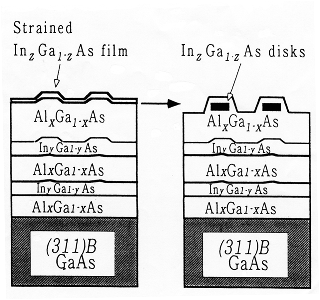
![[GlobalNews Home]](../globe.gif)
![[Prev Page]](/images/arrow-left.gif)
![[Next Page]](/images/arrow-right.gif)

We have found a new self-organizing phenomenon in the metallo-organic vapor phase epitaxy of strained InGaAs/AlGaAs multilayer structures on GaAs (311)B substrates that overcomes the present difficulties associated with the fabrication of quantum-box structures. After the growth of a strained InGaAs layer onto a thick AlGaAs buffer layer, the originally flat InGaAs film organizes spontaneously into homogeneous nanoscale islands embedded in AlGaAs microcrystals (see figure). Since no AlGaAs has been grown after the InGaAs film, this implies that the AlGaAs microcrystals are formed due to lateral mass transport from the buffer layer. Details of the formation mechanism can be found in Nature, vol. 369, p.131, (1994). This unique interaction between the strained InGaAs film and the AlGaAs buffer layer produces well ordered and high density arrays of AlGaAs microcrystals containing disk-shaped InGaAs quantum-box structures. Moreover in our system we can control independently the size and distance of the disks in a wide range by the In content and the InGaAs layer thickness, respectively.
Since no artificial patterning procedure is necessary to define the lateral structure, our quantum disks exhibit excellent crystal quality and homogeneity in size which is most directly evidenced in the high luminescence efficiency at room temperature and the narrow linewidth. In fact, the narrow luminescence linewidth at room temperature (13 meV) reveals reduced thermal broadening in our disks due to efficient lateral confinement of the photogenerated carriers, highlighting the potential of this new self-organizing quantum-box structure for many applications in advanced optoelectronic devices.
Richard Nötzel,
NTT Optoelectronics Laboratories
Present address:
Department of Electrical Engineering
Hokkaido University
e-mail: notzel.ricardel@E5.hines.hokudai.ac.jp
![[GlobalNews Home]](../globe.gif)
![[Prev Page]](/images/arrow-left.gif)
![[Next Page]](/images/arrow-right.gif)